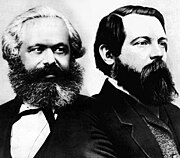San Francisco's DBT: COMMUNISM, SWALLOW IT!
And we got snookered into/descended into this How?
Wiki has;
Cultural Hegemony
In Marxist philosophy, cultural hegemony describes the domination of a culturally diverse society by the ruling class, who manipulate the culture of the society — the beliefs, explanations, perceptions, values, and mores — so that their ruling-class Weltanschauung becomes the worldview that is imposed and accepted as the cultural norm; as the universally valid dominant ideology that justifies the social, political, and economic status quo as natural and inevitable, perpetual and beneficial for everyone, rather than as artificial social constructs that benefit only the ruling class.[1][2] In philosophy and sociology, the term cultural hegemony communicates denotations and connotations derived from the Ancient Greek wordhegemony (leadership and rule), the geopolitical method of indirect imperial dominance, with which the hegemon (leader state) rules sub-ordinate states, by the implied means of power, the threat of the threat of intervention, rather than by direct military force, that is, invasion, occupation, and annexation.[3]
[edit]Background
| Part of a series on |
| Marxism |
|---|
 |
[edit]Etymologic
In Ancient Greece (8th c. BC – AD 6th c.), hegemony (leadership) denoted the politico–military dominance of a city-stateupon other city-states, as in the Hellenic League.[2] In the 19th century, hegemony (rule) denoted the geopolitical and cultural predominance of one country upon other countries, as in the European colonialism imposed in the Americas, Africa, and Asia.[4] In the 20th century, the political-science denotation of hegemony (dominance) expanded to include the ruling-class cultural domination of a socially stratified society. By manipulating the culture (values and mores) of the society, the ruling class can intellectually dominate the other social classes with an imposed worldview that ideologically justifies the social, political, and economic status quo as natural and normal, inevitable and perpetual.[2][5][6][7]
[edit]Historical
In 1848, Karl Marx proposed that the economic recessions and practical contradictions of a capitalist economy would provoke the working class to proletarian revolution, depose capitalism, restructure societal institutions (economic, political, social) per rational, socialist models, and thus begin the transition to a communist society. Therefore, the dialectical changes to the functioning of the economy of a society determine its social superstructures (culture and politics), and the composition of its economic and social classes. To that end, Antonio Gramsci proposed a strategic distinction, between a War of Position and a War of Manœuvre. The war of position is an intellectual and cultural struggle wherein the anti-capitalist revolutionary creates a proletarian culture whose native value system counters the cultural hegemony of the bourgeoisie. The proletarian culture will increase class consciousness, teach revolutionary theory and historical analysis, and thus propagate further revolutionary organisation among the social classes. On winning the war of position, socialist leaders would then have the necessary political power and popular support to begin the political manœuvre warfare of revolutionary socialism.
[edit]Cultural hegemony
The initial, theoretic application of cultural domination was as a Marxist analysis of economic class (base and superstructure), which Antonio Gramsci developed to comprehend social class; hence, cultural hegemony proposes that the prevailing cultural norms of a society, which are imposed by the ruling class (bourgeois cultural hegemony), must not be perceived as natural and inevitable, but must be recognized as artificial social constructs (institutions, practices, beliefs, et cetera) that must be investigated to discover their philosophic roots as instruments of social-class domination. That such praxis of knowledge is indispensable for the intellectual and political liberation of theproletariat, so that workers and peasants, the people of town and country, can create their own working-class culture, which specifically addresses their social and economic needs as social classes.
In a society, cultural hegemony is neither a monolithic, intellectual praxis, nor a unified system of values, but a complex of stratified social structures, wherein each social and economic class has a societal purpose and an internal class-logic that allows its members to behave in a way that is particular and different from the behaviours of the members of other social classes, whilst co-existing with them as constituents of the society. As a result of their different social purposes, the classes will be able to coalesce into a societywith a greater social mission. When a man, a woman, or a child perceives the social structures of bourgeois cultural hegemony, personal common sense performs a dual, structural role (private and public) whereby the individual person applies common sense to cope with daily life, which explains (to himself and to herself) the small segment of thesocial order stratum that each experiences as the status quo of life in society; “the way things are”. Publicly, the emergence of the perceptual limitations of personal common sense inhibit the individual person’s perception of the greater nature of the systematic socio-economic exploitation made possible by cultural hegemony. Because of the discrepancy in perceiving the status quo — the socio-economic hierarchy of bourgeois culture — most men and women concern themselves with their immediate (private) personal concerns, rather than with distant (publicly) concerns, and so do not think about and question the fundamental sources of their socio-economic oppression, and its discontents, social, personal, and political.[8]
The effects of cultural hegemony are perceptible at the personal level; although each person in a society lives a meaningful life in his and her social class, to him and to her, the discrete social classes might appear to have little in common with the private life of the individual man and woman. Yet, when perceived as a whole society, the life of each person does contribute to the greater societal hegemony. Although social diversity, economic variety, and political freedom appear to exist — because most people see different life-circumstances — they are incapable of perceiving the greater hegemonic pattern created when the lives they witness coalesce as a society. The cultural hegemony is manifested in and maintained by an existence of minor, different circumstances that are not always fully perceived by the men and the women living the culture.[9] (See:Entfremdung, Karl Marx’s theory of alienation)
[edit]Intellectuals and cultural hegemony
In perceiving and combating cultural hegemony, the working class and the peasantry depend upon the intellectuals produced by their society, to which ends Antonio Gramsci distinguished between bourgeois-class intellectuals and working-class intellectuals, the proponents and the opponents of the imposed, normative culture, and thus of the societalstatus quo:
Since these various categories of traditional intellectuals [administrators, scholars and scientists, theorists, non-ecclesiastical philosophers, etc.] experience through anesprit de corps their uninterrupted historical continuity, and their special qualifications, they thus put themselves forward as autonomous and independent of the dominant social group. This self-assessment is not without consequences in the ideological and political fields, consequences of wide-ranging import. The whole of idealist philosophy can easily be connected with this position, assumed by the social complex of intellectuals, and can be defined as the expression of that social utopia by which the intellectuals think of themselves as “independent” [and] autonomous, [and] endowed with a character of their own, etc. [10]
The traditional and vulgarized type of the intellectual is given by the Man of Letters, the philosopher, and the artist. Therefore, journalists, who claim to be men of letters, philosophers, artists, also regard themselves as the “true” intellectuals. In the modern world, technical education, closely bound to industrial labor, even at the most primitive and unqualified level, must form the basis of the new type of intellectual. . . . The mode of being of the new intellectual can no longer consist of eloquence, which is an exterior and momentary mover of feelings and passions, but in active participation in practical life, as constructor [and] organizer, as “permanent persuader”, not just simple orator. [11]
[edit]Gramsci’s intellectual influence
In the event, cultural hegemony has philosophically influenced Eurocommunism, the social sciences, and the activist politics of sociallyliberal and progressive politicians. The analytic discourse of cultural hegemony is important to research and synthesis in anthropology, political science, sociology, and cultural studies; in education, cultural hegemony developed critical pedagogy, by which the root causes of political and social discontent can be identified, and so resolved.
In 1967, the German student movement leader Rudi Dutschke reformulated Antonio Gramsci’s philosophy of cultural hegemony with the phrase Der lange Marsch durch die Institutionen (The Long March through the Institutions), denoting the war of position, an allusion to theLong March (1934–35) of the Communist Chinese People's Liberation Army, by means of which, the working class would produce their own organic intellectuals and culture (dominant ideology) to replace those imposed by the bourgeoisie.[12][13][14][15][16]
[edit]See also
- Cultural capital
- Cultural conflict
- Cultural imperialism
- Dominant ideology
- Domination and the Arts of Resistance: Hidden Transcripts (1990), by James C. Scott
- Hegemonic masculinity
- Hegemony and Socialist Strategy (1985), by Ernesto Laclau and Chantal Mouffe
- Nicos Poulantzas
- Political consciousness
- Post-hegemony
- Social capital
- Southern strategy
- The Structural Transformation of the Public Sphere: An Inquiry into a Category of Bourgeois Society (1962), by Jürgen Habermas
[edit]References
- ^ Bullock, Alan; Trombley, Stephen, Editors (1999), The New Fontana Dictionary of Modern Thought Third Edition, pp. 387–88.
- ^ a b c The Columbia Encyclopedia, Fifth Edition. (1994), p. 1,215.
- ^ Ross Hassig, Mexico and the Spanish Conquest (1994), pp. 23–24.
- ^ Bullock & Trombley 1999, pp. 387–88.
- ^ Clive Upton, William A. Kretzschmar, Rafal Konopka: Oxford Dictionary of Pronunciation for Current English. Oxford University Press (2001)
- ^ Oxford English Dictionary
- ^ "Timeline", US Hegemony, Flagrancy
- ^ Hall, Stuart (1986). "The Problem of Ideology — Marxism without Guarantees" (PDF). Journal of Communication Inquiry 10 (2): 28–44. doi:10.1177/019685998601000203.
- ^ Gramsci, Antonio (1992). Buttigieg, Joseph A. ed. Prison Notebooks. New York City: Columbia University Press. pp. 233–38. ISBN 0-231-10592-4. OCLC 24009547.
- ^ Selections from the Prison Notebooks of Antonio Gramsci (1971), Quentin Hoare and Geoffrey Nowell Smith, eds., pp. 7–8.
- ^ Selections from the Prison Notebooks of Antonio Gramsci (1971), Quentin Hoare and Geoffrey Nowell Smith, eds., pp. 9–10.
- ^ Gramsci, Buttigieg, Joseph A, ed., Prison Notebooks (English critical ed.), p. 50, "Long March Through the Institutions21"
- ^ Buttigieg, Joseph A. (2005). "The Contemporary Discourse on Civil Society: A Gramscian Critique". Boundary 2 32 (1): 33–52. doi:10.1215/01903659-32-1-33. ISSN 0190-3659. Retrieved 2010-06-30.
- ^ Davidson, Carl (6 April 2006) (web log), Strategy, Hegemony & ‘The Long March’: Gramsci’s Lessons for the Antiwar Movement.
- ^ Marsch durch die Institutionen at German Wikipedia.
- ^ Antonio Gramsci: Misattributed at English Wikiquote for the origin of “The Long March Through the Institutions” quotation.
[edit]External links
- (archive) Gramsci, Marxists.
- International Gramsci society.
- Gramsci, journal, AU: UOW.
- Rethinking Marxism.
- (review) Rethinking Marxism: Association for economic & social analysis, EI Net
- Gramsci, "Selections", Prison notebooks, Marxists.
- Gramsci, Prison notebooks, Marxists.
[edit]Further reading
- Beech, Dave; Andy Hewitt and Mel Jordan (2007). The Free Art Collective Manifesto for a Counter-Hegemonic Art. England: Free Publishing. ISBN 978-0-9554748-0-4.OCLC 269432294.
- Bullock, Alan; Trombley, Stephen, eds. (1999), The New Fontana Dictionary of Modern Thought (3rd ed.).
- Flank, Lenny (2007). Hegemony and Counter-Hegemony: Marxism, Capitalism, and Their Relation to Sexism, Racism, Nationalism, and Authoritarianism. St. Petersburg, Florida: Red and Black Publishers. ISBN 978-0-9791813-7-5. OCLC 191763227.
- Gramsci, Antonio (1992), Buttigieg, Joseph A, ed., Prison notebooks, New York City: Columbia University Press, ISBN 0-231-10592-4, OCLC 24009547
- Abercrombie, Nicholas; Turner, Bryan S. (June 1978). "The Dominant Ideology Thesis". The British Journal of Sociology (The London School of Economics and Political Science: Wiley-Blackwell) 29 (2): 149–70. Retrieved September 17, 2012.


No comments:
Post a Comment